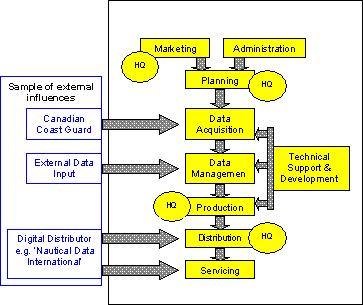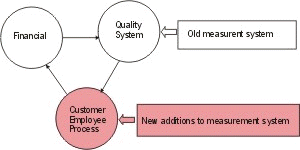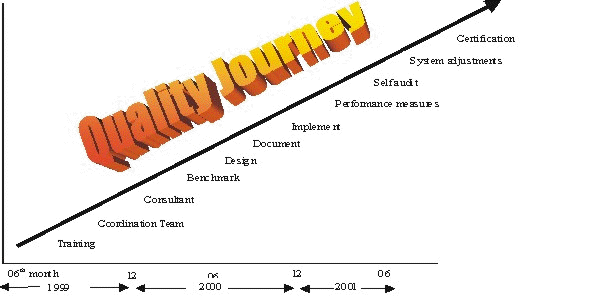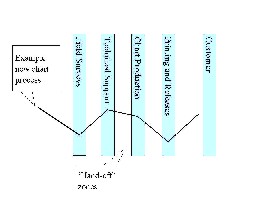- A Journey for CHS (Canadian Hydrographic Service)
|
|||||||||||||||||||||||||||||||||||
| Craftsman | Guild/Standards | Mass Production/Tasks | Scientific Management Inspection Office |
Process Management ISO 9000 |
|
|
||||
|
|
||||
| Explorers | HOs IHO standards |
Specialization | Digital processing Multi-disciplinary |
Quality management System |
Figure 1. A comparison of timelines
The changes in the nature of quality control for the hydrographer are similar to the fate of the craftsman. The feedback loop in terms of improvement, satisfaction and process was very tight in the days when the chartmaker was the explorer and the explorer was the navigator. As the science became more refined the role of the hydrographer diverged into the three disciplines: cartographer, hydrographic surveyor and navigation officer. This was essential to meet the high demands for specialization driven by an increasingly sophisticated science. The tools and the training became very specialized in these disciplines and they evolved to be almost sciences or art forms of their own.
Not unlike the results of mass production or the tasking of work that was imposed on the craftsman’s trade, the benefits of being the customer and the producer were being lost. Standards were developed both nationally and internationally to control the quality of the product to specifications. Training standards emerged to help control the processes. All of this worked very well when the pace of change was slow enough and resources vast enough to permit a period of apprenticeship. The art form was essentially passed down by word of mouth and along with this transfer of knowledge came the transfer of a culture.
4. The Current Reality for CHS
The last 20 years and in particular the last ten years have brought enormous changes in technology and resources for the CHS. The pace of change has rocked the once stable environment of processes, quality control, development and culture.
4.1 Processes
The transition from manual production to digital production has destabilized processes. The loss of experienced staff through a 30% work force reduction has eroded the knowledge base. These two transitions together worked to short-circuit the stable production-line processes that had worked so well for so many years.
CHS had a well-defined production sequence combined with an abundance of knowledgeable staff that created a safety net of experience. The digital revolution destabilized this well-established pattern. The earlier manual production was more an art form that required patience and practice. It followed rigid routines and new staff entered on the apprenticeship program. This system was not flawless but it was guided by the experience of many people over many years.. In some areas of production the process has matured and is relatively stable, while in others the changes in software and process continue at a rapid pace. The digital production process is not well defined: little documentation exists and only a few people have long experience in the process. New and relatively inexperienced production staff are tasked with generating products from start to finish without mentors and without the benefit of a mental model or documentation of the processes which results in re-work and increased checking.
A secondary impact of high rates of retirement of experienced staff is a high rate of change in senior staff positions within the production units. As new members assume the roles, they too lack the mental models and documentation. These ‘new eyes’ do not bring the baggage of past experience but nevertheless it is important that they understand the old process in order to make solid, logical steps toward a new process.
Adding to the upheaval in paper chart production has been the introduction of the Electronic Navigational Chart (ENC) and raster chart lines of production. The ENC was a revolutionary change in the production paradigm. The rate of change in process, specifications, and tools was unsettling and further distanced production staff from traditional roots of well-defined processes. Very little documentation existed and as staff learned new techniques in Regional isolation there was little opportunity to develop ‘best-practice’ and learn collectively from mistakes. The complexity of the S-57 ENC product has driven development of digital scripts to validate the integrity of the data but these routines are in their infancy.
4.2 Evidence in Quality Control
CHS no longer has the luxury to rely on ‘redundant checks’ to catch all the imperfections in production. In the digital world it is no longer possible to view a hard copy mosaic or alterations to printing negatives as evidence of work performed. Only clear and unambiguous documented evidence of tasks and processes undertaken in the course of production is adequate guarantee of performance and quality. The lack of clear checking procedures for all levels of production is a hindrance to both peer checks and Quality Control office checks.
The current methodology of product realization has end-loaded much of the quality inspection. This is a result of the combination of the former draftsperson and compiler roles into one digital multi-disciplinary role. Ironically, this one-person control is closer to the craftsman model of work. But the process was broken into segments in the manual world and then in the digital world strung back together without the overall model, training and control of process. The hand-offs from draftsperson to compiler were formerly a trigger for inspection but these have been lost in the one-person digital production line. Support for this end-load checking comes from the feeling that a quality review will slow the production schedule and it is therefore best to leave it to last. In fact, the quality control office is now backlogged as a result of the sheer effort in quality controlling a project near the end of the cycle. The result of detecting early-production errors late in the process creates a great amount of re-work and is frustrating for production staff.
4.3 Process Improvement
CHS has always been aggressive in the arena of change and process improvement. Generally, however, these have been guided by intuition. Though this has served us well, the lack of a formal problem-solving approach has left us with a long list of ailments that have plagued CHS for years. Failed attempts at fixing bugs in software, in specifications, and in processes have left many staff simply accepting workarounds as standard procedures and avoiding the reports of production bugs altogether. None of these ailments by themselves are critical but the compounded effort of dealing with small items over a period of time is significant.
It is accepted wisdom in industry that any organization without a structured approach to process improvement experiences 10%-30% waste, or non value-added work, in their processes. This is precisely the type of waste CHS produces by not optimizing its production processes to reduce effort that is redundant or performed as the result of an inadequate process. Redundant quality control checks, redundant Navaids checks, repeated discussion of out-of-date specifications and many more imperfections in our processes consume effort and energy that can no longer be sustained. The tools to isolate these areas of waste and then to quantify and analyze alternatives for action do exist but are rarely used in CHS decision-making or reporting processes. Communication and coordination between production streams to make processes more efficient is lacking. Strategies for improvements in CHS methods should be designed in the standard systems management format of Plan-Do-Check-Act, with focus on the organization as a whole in order to optimize overall production objectives.
4.4 Organizational Culture
The right attitude in an organization is an essential ingredient to success. Job satisfaction, teamwork, communication, feedback, purpose, visibility and recognition are all key elements that work together to produce the right attitude and the right environment (win-win culture). The business environment of today is plagued with a revolving door of deadlines and an endless list of pressures, driven by the need to survive in an increasingly competitive world. It is not surprising that the fragile human factors of job satisfaction, communication, feedback and recognition are overlooked or undervalued. People who feel charged by their work and loyal to their organization are that way because the work objectives are clear, the tools to perform the tasks are available, the feedback on performance is accurate and constructive, and a sense of team is prevalent in their part of the organization.
5. The CHS model for a Quality Management System
In 1995, a pilot project of ISO 9000 certification was initiated in the CHS Laurentian office located in Mont-Joli, Quebec. The Laurentian office had experienced a high turnover of personnel resulting from the office relocation from Québec to the more remote Mont-Joli and as result, the staff was relatively young and open to change. It was also an opportunity to document processes to capture the intellectual capital remaining with the retained staff while aiding in the training and dissemination of this knowledge. Laurentian Region was certified to the ISO 9002 standard in 1997.
The primary benefits realized in the Laurentian Region as result of the implementation of the ISO 9000 standard are [Labonté, 1999]:
- The absorption of the quality control officers’ workload into the production-line process
- The establishment of a more rigorous management framework
- The streamlining of processes to eliminate duplication and standardize procedures
- The managing of non-conformities using root-cause analysis which resulted in improvements to productivity and quality
- Improvement of strategic planning through audits that identify strengths and weaknesses
- Documentation and uniform procedures facilitated training and rotation of employees
- Improved customer interface in terms of response time and analysis of non-conformities
- Increase in the level of pride and confidence of quality and work amongst employees
CHS initiated a national project for a Quality Management System in June 1999 with a target date for ISO 9001 certification in June 2001. Each of the four Regional offices across Canada, and CHS Headquarters in Ottawa, will be certified to the ISO 9001:2000 standard. The scope of the certification will cover all of the aspects of operation from administration to production to CHS distribution. Internal links within the organization will be reinforced, especially those between Headquarters and Regions, where dependencies are critical to optimizing quality and efficiency. External links to agencies, with which CHS has moderate dependencies and yet limited influence, will be reinforced to the best level possible. These links will be a combination of communication protocols and service standards.
CHS Regional Processes and HQ Interaction

Figure 2. An outline of a national CHS Quality Management System
6. ISO 9000:2000 Standard
|
CHS will use the ISO 9000:2000 International Standard as the core of its Quality Management System. ISO 9000 is a common-sense management model that defines a business environment. The basis for the Quality Management System (QMS) will be the revised ISO 9000:2000 International Standard. Though the Standard is not scheduled to be finalized until the fourth quarter of the year 2000, it has already gone through 3 drafts that have been largely accepted by the ISO member states. The 2000 version responds better to the demands of the service and public sectors and comes at an opportune time for CHS as it represents a more modern approach to quality management. The most important improvements are the re-organization of the Standard to follow the Plan-Do-Check-Act loop with continuous improvement, emphasis on employee awareness and involvement, and the incorporation of customer feedback into the quality system. The original ISO 9000 family of standards was based on an earlier era of quality thinking that defined quality as primarily a technical problem. In the 1990s, it was recognized that quality had a high human resource component so organizations developed programs to involve workers in quality improvement. Today, it is understood that all work is accomplished through processes that are most productive when properly managed. Process management and human resource management have both become elements of the quality management movement. The revised standard recognizes this human element and bases its philosophy on eight quality principles (see sidebar). The basic business processes prescribed by the ISO 9000 system are: Say what you do. An organization must document its processes that impact on quality. CHS has documentation for its processes but these Specifications are out-of-date. This results in steps overlooked, inconsistencies and questions in accountability. Do what you say. Following procedures reduces variability, prevents known problems, and promotes the benefits of using proven techniques and procedures. Record what you did. This is the key to managing the business based on facts. Without a record of what occurred, made at the time it occurred, an organization is not likely to be able to assess the level of quality effectively and is thus less likely to be able to analyze performance and identify potential problems or anticipate unsatisfactory results. CHS has fallen behind in the level of ‘evidence’ that we compile for production work. Check on the results. Recording results is useless unless the results are analyzed and checked against specifications and other criteria for quality. Act on the difference. If an organization does not take action when results are unsatisfactory or problems are indicated, consistent quality is difficult to maintain and quality cannot be improved. |
Eight Quality Management Principles |
 |
Figure 3. Five steps of ISO 9000 model |
7. Performance Measurement
As part of the feedback loop, CHS will implement performance measurement indicators and benchmarking to aid in the assessment of customer and employee satisfaction, continuous improvement and the general health of the QMS itself. Where financial statistics are the common measurements of an organization it does little to capture and feedback the real impact of changes in resources and priorities. Regular monitoring of performance across all aspects of the organization is necessary for collective assessment of the impact of change and to reveal opportunities for improvement. It is not enough to base decisions on metrics that are biased to one particular measure, for instance the financial bottom line; this ignores potentially more serious measurements such as customer satisfaction.
 |
Figure 4. A balanced approach to performance measurement |
A more balanced system of performance measurement based on the principles of the Balanced Scorecard [Kaplan, 1998] will be implemented to reflect all of the quality principles of the organization. This approach will provide an overall view of performance by combining financial measures and other key performance indicators around the customer/employee perspective, business processes, improvement and innovation.
8. Current progress and implementation
A core CHS team was organized with representatives from each of the five offices across the country. Training and communication initiatives were the first operational objectives. Coordination team members and senior management had in-depth training on the ISO 9000 quality management concepts. Benchmarking, or Gap Analysis, has been completed in each Region to establish strengths and pin point opportunities for areas of improvement. A secondary benefit of this work is an organizational snapshot, hence benchmark, that will aid in assessing the benefits of ISO 9001 implementation at a future date. The design phase of the project is just beginning. This should provide the necessary framework within which the documentation and the performance indicators can be assembled.

Figure 5. Timeline for CHS Quality Management System implementation
Based on the lessons of the CHS pilot project in Laurentian Region, the amount of human resource input into the twenty-four month project will be approximately five person years in each Region. The creation of the required documentation will involve up to one-half of all CHS staff. A number of processes such as audits, document/data control and corrective/preventative action will be of a National nature. At the lower levels of documentation of work instructions the Regional offices may differ due to the unique requirements in each area. Reporting of non-conformities for corrective or preventative action will be one of the processes documented early to begin capturing indicators of possible areas for improvement. As each process is documented it will be immediately put into use along with associated internal audits to refine and improve the documentation and the process itself. As documentation is developed in one Region it will be shared with other Regions to promote ‘best practice’ and to minimize duplication of effort.
Training in the areas of teamwork, documentation, ISO 9000 fundamentals, quality system design, audit process and Registrar selection will all be supported by an ISO 9000 Quality System Consultant. BRI International Inc. has been contracted by CHS to take the training and guidance role to ensure that the quality system is developed to comply with the ISO 9000 standard and is maximized in terms of its flexibility, value and maintainability.
9. Benefits for CHS
An ISO 9000 quality system will generate many benefits for CHS. Some of these will be realized very quickly although others will take time to evolve.
CHS is expecting improved internal communication in both the short-term and long-term. The common documentation and systems-thinking approach of the Quality Management System will build a bridge for the sharing of best-practices and process improvements. As CHS moves closer to the concept of process management for the realization of its publications it is expected that refinements in the hand-off zones will result from reinforced communication and better measurement. The management of data in and out of divisional hierarchies is an area ripe for improvement: the process management model of ISO 9000:2000 and the commitment to multi-disciplinary training of staff are a wonderful recipe for gains in production.
 |
Figure 6. A simple model of functions vs. process |
The requirement for evidence or proof of process will be built into the system. The consistency of documentation check-sheets, communication protocols and sign-off forms will give bench personnel, supervisors, quality control officers and management ample evidence and confidence to support the advancement and release of products through the system. Traceability, proof of due diligence and uniformity of business process will be an aid to CHS in its management of change and its obligations for legal responsibility.
The commitment to continuous improvement of the quality management system is an integral part of the ISO 9000 model. In the spirit of the Standard the non-conformities or items of concern will be flagged and must be addressed by process owners and management. The formalized management review process in ISO 9000 will strengthen the bonds between various levels of the organization. Performance measurement indicators are also key opportunities for CHS to improve customer satisfaction and to improve its organization in general.
Some of the less tangible benefits will be found in the soul of the QMS. If it is properly designed and implemented it should result in improved communication, confidence, trust, and job satisfaction. If each and every employee can leave the workplace knowing that the system was working for them and not against them then the system is doing its job. If the system is designed well it will put the power for process improvement in the hands of the front-line people. This is what empowerment was intended to do. The impact of an initiative of this sort can have profound effects on culture. The emphases on teamwork, on management involvement, and on investment in front-line processes are the steps towards job satisfaction. The ISO 9000 model of documentation, commitment to continuous improvement and management support are keys to a quality product and to a quality workplace.
10. CONCLUSION
The Canadian Hydrographic Service has started on a long journey. Some say the hardest step is the first: CHS has made that commitment. The road will not be easy. Short-term input of substantial resources is required to develop a quality system. Cultural resistance, apprehension, and shifts in priorities focused on functional goals are all obstacles to be managed along the way. Communication is vital to keeping the initiative alive and on-track.
CHS has chosen the burden of this journey as a prerequisite for survival as a high quality organization. A quality organization must make the commitment to re-enforce its capacity to meet the needs of its customers, to maintain integrity in its data or services, and to earn a workforce loyal and competent to delivering the trust that is inherent in the craftsman’s Seal.

|
The Canadian Hydrographic Service is committed to high quality in every aspect if its work. |
Reference
Juran, J.M., 1995, A History of Managing for Quality, Milwaukee, ASQC Quality Press
Juran, J.M. 1979, Quality Handbook 5th Edition, Quality in Japan, New York, McGraw-Hill
Kaplan, R.S., Norton, D.P., 1998, The Balanced Scorecard – Measures the Drive Performance, Measuring Corporate Performance, pages 123-146, Boston, Harvard Business School Press
Labonté, S., Evaluation – Pilot Project Implementation of ISO 9002 CHS-Laurentian Region, CHS report, unpublished.
Meyer, C., 1998, How the Right Measures Help Teams Excel, Measuring Corporate Performance, pages 99-122, Boston, Harvard Business School Press
Peach, R.W., 1997, ISO 9000 Handbook 3rd Edition, New York, McGraw-Hill
Walton, M., 1988, The Deming Management Method, New York, Berkeley Publishing
BIOGRAPHICAL NOTE
Sean Hinds has worked for the Canadian Hydrographic Service for 20 years. Twelve of those years were as a field hydrographer in numerous locations including Canada’s high Arctic. Sean was commissioned as a Canada Lands Surveyor in 1987. In 1992, Sean migrated to the chart production world where he supervised a paper production unit for four years. From 1996-1998 Sean managed the Electronic Navigation Chart Division of CHS, Central and Arctic (C&A) Region. Since 1999 he has held the position of Head, Quality Management C&A Region. Sean is the national Project Leader for the CHS ISO 9000 Quality Management System initiative.
Published works include:
- Next Generation Printing for a Digital World, Sean Hinds, Paul Holroyd, Dave Monahan 1996
- Preparing a Hydrographic Office for ECDIS, Julian Goodyear, Mike Casey, Sean Hinds 1999
Sean Hinds
Canadian Hydrographic Service
Central & Arctic Region
E-mail: hindss@dfo-mpo.gc
27 March 2000